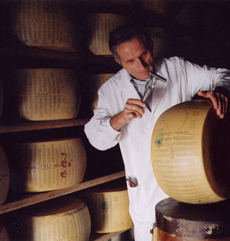TIP OF THE DAY: Multi-Tasking Parmigiano
|
|
October 27th is National Parmigiano-Reggiano Day. Parmigiano-Reggiano is more than a great cheese for pasta, pesto, risotto and Alfredo sauce. Shave it onto salads, eggs and sandwiches. Add it to cheese plates. Enjoy it with a glass of hearty red wine. It loves to be paired with apples, figs, grapes, kiwi, peaches, pears and walnuts. Italians enjoy it for dessert, drizzled with a few drops of aged balsamic vinegar. Guests love large chunks of the cheese with a variety of dipping sauces—like pesto, garlicky tomato sauce, olive tapenade, parsley sauce and fruit chutney—on individual plates, or on a communal plate of skewers. |
|
|
THE DIFFERENCE BETWEEN PARMIGIANO-REGGIANO & GENERIC PARMESAN Anyone, anywhere can make and sell a cheese called “Parmesan.” They follow a basic recipe and are under obligation to nobody to adhere to any standards, including aging it until full flavors develop. Parmigiano-Reggiano, on the other hand, is D.O.P. name-protected (Denominazione d’Origine Protetta). This is a legal protection for the consumer that guarantees that you are buying an authentic Parmigiano-Reggiano, made by a trained artisan to exacting specification, produced in a specific geographical area, from milk from specific herds of animals raised in the same area, using techniques honed for centuries. Even the feed of the cows is dictated. All of this activity is strictly supervised by a consortium (“consorzio”) that ensures that every wheel stamped with the official seal tastes exactly as it should. After 12 months of aging (the minimum), each wheel is inspected and sometimes, if other tests for flaws fail, a thin probe will be inserted to draw out a small piece of the interior core (see photo). If the cheese does not pass, the exclusive pin-dot pattern on the sides is scraped off. The cheese can be sold as cheese for grating, but not as Parmigiano-Reggiano. If it does pass, it can go on aging for up to 36 mnths. Why are the words, Parmigiano-Reggiano and Parmesan, capitalized? Because they refer to the city of Parma in Italy, the center of making this great cheese. However, both cheeses have a place at your table.
|
||



